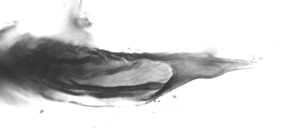Chironomus striatipennis immatures
Fourth instar Larva: a small plumosus-type (length 7-12.3 mm)(fem. 10.9 (9.7-12.3 mm); specimens of Chaudhuri et al (1992) (7.0-8.2 mm) but this may be due to being reared in a laboratory. Anterior and posterior Ventral tubules about equal length or anterior longer (ant 1.20-1.56 mm, post 1.24-1.48 mm); Lateral projections about 300 (280-320) µm. Anal tubules about 303 (250-380) µm long and 2.7 times longer than wide. Salivary reservoir about 53-55.5 µm wide and about 3 times wider than deep.
Gula from pale to (mostly) slightly darkened over posterior 1/3; and frontoclypeus also from pale to occasionally dark, generally the darker specimens are from Uttar Pradesh.
Distance between antennal bases (142.8 (124-163) µm) generally greater than the distance between the S4 setae (137 (127-145) µm).
Mentum (Fig. c) with C2 teeth of central tooth separated and sharp (type IB-III), 4th lateral reduced, sometimes only slightly, or down to level of 4th lateral (type I-ii). Pecten epipharyngis (Fig. a) with 14.3 (11-17) teeth (type B).
Ventromental plates (Fig. d) separated by 0.27 (0.22-0.32) of the mentum width (ICD), about 38.5 (32-46) striae, VMR about 0.26 (0.22-0.29).
Premandibles with inner tooth about 4.64 (3.6-6) times wider than the outer tooth; outer tooth to fine point, inner to moderate point (Ty.2B).
Antenna (Fig. b) with basal segment relatively long, 2.7-3.7 times longer than wide; Ring organ from about 0.3-0.45 up from base of segment; AR about 1.91 (1.6-2.1); proportions (µm) 93 : 23 : 9 : 11 : 6.
Mandible (Fig. e) with third inner tooth partially or completely separated, and partially pigmented (i.e. type IIB or IIIB, but may be IA or IIA in Jammu & Kashmir), with 15.7 (13-18) furrows near base; 12 (11-14) taeniae in Pecten mandibularis; Mdt-Mat abt 28 µm; MTR about 0.35 (0.30-0.37.
Pupa: Length about 6.5 (5.4-7.6) mm (male) 5.3 (4.8-5.8) (female), posterior margin of wing case about 1.09-1.28 mm. The size of the Chaudhuri et al (1992) specimens is lower. Dark brown, exuvia pale brown.
Head: Cephalic tubercles about 62 (40-80) µm long and about 48 (40-65) µm wide at the base, with a subterminal seta about 57 µm long.
Thorax: Prealar tubercle present, not simple, but small, about 25 µm long and 6 µm wide. Basal ring of respiratory horn with edge thicker at the anterior end, and pinched at the centre, about 129.5 (126-133) µm long and 62 (60-64) µm wide; HR about 2.17.
Abdomen: About 67 (62-72) recurved hooks on posterior margin of segment II, the hook row covering about 54% of the width of the segment. Pedes spurii B on segment II, and pedes spurii A on segment IV, while those of segment V and VI are small and mainly identifiable by the spinules, on seg V these spines run all along the edges of the segment.
Caudolateral spur of segment VIII generally with 1 main spine (see below), but occasionally with 1 or 2 subsidiary ones or a broad shoulder.
Anal lobe with about 53 taeniae on each side, mostly in a single row.

Cytology: Four polytene chromosomes with the pseudothummi-cytocomplex combination AE, BF, CD, G. Centromeres with some degree of heterochromatinization.
Nucleolus subterminal on arm G. No nucleoli on long arms. End of arm G bearing nucleolus, typically unpaired, with BR near other end.
Polymorphism in arms A, B, C, D, E, and F. Saxena also recorded a tandem fusion between arm A and B, and a small deletion near the distal end of arm B.
stpA1: 1 - 2c, 11 - 7, 4 - 6, 2d - 3, 12 - 19
stpA2: 1a-d, 10d - 12, 3 - 6a, 7 - 9, 4 - 6, 2i - 1e, 10a-c, 16 - 17, 13 - 15, 16 - 19
stpB1: Puff virtually terminal with only the dark bands (6a-f, 7ab) distal
stpB2: simple inversion of B1, shares proximal breakpoint with B4, B5, B6.
stpB3: Slightly longer inversion than B2, distal break at least 10 bands distal of B2 break.
stpB4: Shares distal break with B2, proximal breakpoint shared with B5, B6 & B8.
stpB5: Proximal breakpoint shared with B4, B6 & B8, distal with B3.
stpB6: Proximal breakpoint shared with B4, B5 & B8, distal breakpoint shared with B7.
stpB7: Proximal breakpoint closer to centromre, distal breakpoint shared with B6.
stpB8: Proximal breakpoint shared with B4, B5 & B6, distal breakpoint just proximal to puff of group 7.
stpC1: Characteristic groups 3-4 about 1/3 from centromere.
stpC2: Simple inversion of almost the whole arm. Shares proximal breakpoint with C3.
stpC3: Shares proximal breakpoint with C2 and distal breakpoint with C4.
stpC4: Shares distal breakpoint with C3 and proximal breakpoint with C5. (India, Japan & Brazil).
stpC5: Shares proximal breakpoint with C4.
stpD1:
stpD2: Small simple proximal inversion.
stpD3: Simple inversion of distal 2/3 of arm. Shares distal breakpoint with D4.
stpD4: Large inversion of about 3/4 of the arm. Shares distal breakpoint with D3
stpE1: 1a - 13g i.e. Standard
stpE2: 1 - 2c, 8 - 2d, 9 - 13
stpF1: 1 - 2a, 15e - 11f, 2b - 15f-a, 11a-e, 16 - 23
stpF2: 1a, 21c - 16, 11e-a, 15a - 2b, 11f - 15e, 2a - 1b, 21d - 23 from stpF1 (from Saxena)
stpF3: 1 - 2a, 15e - 14, 18 - 16, 11e-a, 15a - 2b, 11f - 13, 19 - 23 from stpF1 (from Saxena)
stpF4: 1 - 2a, 15e - 14, 16f-a, 11f-a, 15a - 2b, 11f - 13, 16g - 23 from stpF1 (from Saxena)
stpG1: Nucleolus subterminal. A large BR may be developed in some localities.

Polytene chromosomes of C. striatipennis
[ Return to Index | Go to C. striatipennis adults | Go to C. kiiensisis adults |Go to References ]
|

